copyright © 2011 Douglas Tong, all rights reserved
The following text is the complete interview with Kajitsuka Yasushi Sensei, the Secretary General of the Nihon Kobudo Shinkokai (the Society for the Promotion of Japanese Classical Martial Arts and Ways) (日本古武道振興会), the oldest national association of the classical styles of Japanese budo and bujutsu (koryu) in Japan. Created in 1935, this association held its 75th Anniversary Festival in the summer of 2010 (August 15, 2010).
Kajitsuka Sensei is also the headmaster of the Ohtsubo branch of the Owari Line of Yagyu Shinkage Ryu and soke of the Edo-Line of Yagyu Shingan Ryu.
In Part One, Kajitsuka Sensei tells us some facts about the Festival. In Part Two, he tells us about his role in the Nihon Kobudo Shinkokai. In Part Three, he outlines the history and purpose of the Nihon Kobudo Shinkokai. Finally, In Part Four, Kajitsuka Sensei talks about the purposes, goals, and theory of budo associations in general.
Those interested in learning more about Kajitsuka Sensei can consult his group’s website: Arakido
__________________________________________________________
Part One: About the 75th Anniversary Festival
Question: Where was the Festival held?
Sensei: The venue was the Nakano Sunplaza.
*The Nakano Sunplaza is a large hotel in Tokyo that houses a large concert hall. It is located in Nakano-ku, one of the wards of Tokyo. Nakano lies just west of Shinjuku, one of the famous districts of Tokyo.
For more information about Nakano Sunplaza, see their official website: Nakano Sunplaza
Question: Why was it decided to hold the Festival at that place?
Sensei: The last festival (the 70th Anniversary) was held at the same place, Nakano Sunplaza. Therefore, since the staff of Nakano Sunplaza had some previous experience with us and knew exactly what we required for the festival, we decided to hold it again at their place.
Question: How many people attended (general attendance)?
Sensei: The overall attendance (which includes our members, the press, our guests) was more than 300. We don’t know the exact number of only the general attendance because it was free admission.
Question: Were there any problems either before or during the Festival?
Sensei: There were no serious problems. Everything went smoothly.
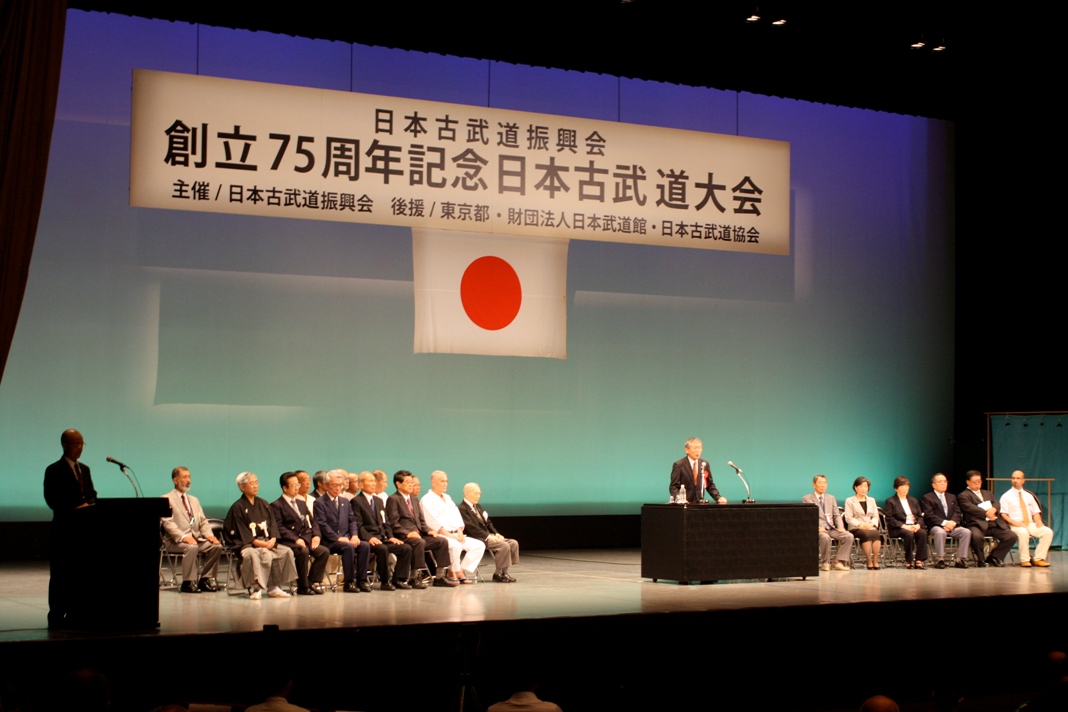 The opening ceremony
The opening ceremony
Question: What is the goal (objective) of the Festival?
Sensei: We have several goals for this festival. First, we would like to have many people know about Kobudo, to learn about Japanese traditional culture, and also to learn about our association, the Kobudo Shinkokai. Second, festivals like this one also have the purpose of recording the skill of the tradition.
Question: Can you tell us which groups (i.e., Ryuha) participated in the Festival?
Sensei: 57 Ryuha attended. In our association, there are actually 77 Ryuha (full members). 279 association members participated in this festival.
Question: Were the Ryuha all from the same budo category (e.g., kenjutsu) or from many different categories (e.g., bojutsu, naginatajutsu, jujutsu, etc…)?
Sensei: They were from many different categories.
Question: How many different categories were included? Why did you choose these specific categories (and not other categories)?
Sensei: Please refer to the list of our members. It is difficult to classify because many Ryuha have some techniques in several different categories*.
* In other words, some styles may have a specific branch dealing in jujutsu and another section dealing in kenjutsu or naginata jutsu, and so on. So some styles cover a few different categories.
Question: Are the Ryuha free to decide what they wish to demonstrate or did you have certain rules about what they could and could not do? For example, did all groups demonstrate only or did some groups have seminars, etc..?
Sensei: It was only demonstrations. Every Ryuha performed a 10 minute demonstration, more or less.
Question: Was there some kind of party or get-together for everyone after the festival?
Sensei: We had the 75th anniversary party after the festival.
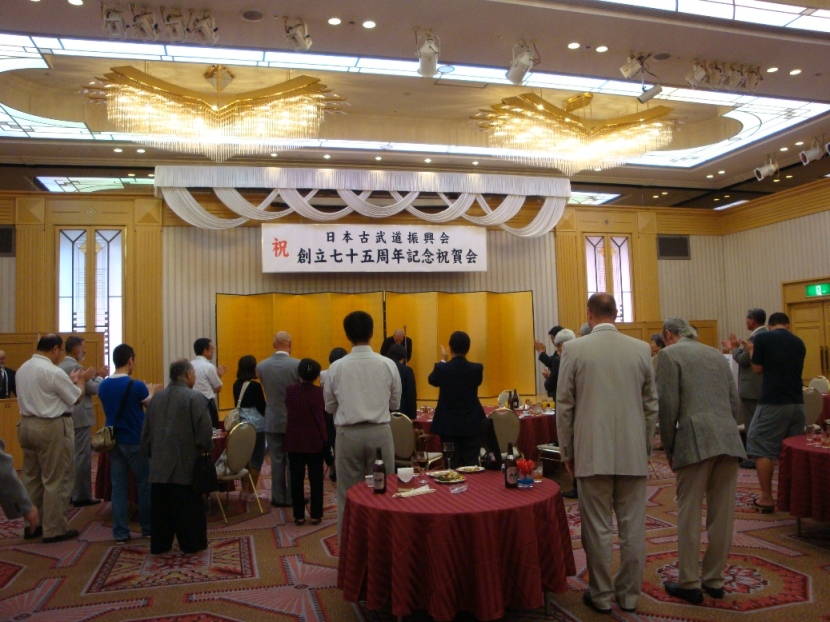 The party after the demonstration
The party after the demonstration
Question: I see. Are there any final words you would like to say to conclude this section of the interview?
Sensei: Yes. I would like to explain more about the Kobudo Shinkokai. Today, the Kobudo Shinkokai is a voluntary group, a non-profit group. Each member pays an annual membership fee. In addition, each member pays the entrance fee for each Enbukai (demonstration). Each Enbukai is financed and made possible by the members’ entrance fees. The membership of our association consists of the special members, such as the representative of the Ryuha (e.g., the Soke, etc.), and the regular members (i.e., people who belong to the Ryuha). There are 77 styles (Ryuha) officially registered in our association. The total number of members (both special and regular members) is approximately 800 people.
Question: Thank you, Sensei.
———————————————————–
Here are some sites where you can view videos of the embu (demonstrations) of some of the schools that participated:
Foundation of the Nihon Kobudo Shinkokai: 75th Anniversary Celebration
__________________________________________________________
Part Two: About the Role of the Secretary General
Question: You became the Secretary General of the Nihon Kobudo Shinkokai. What are your responsibilities in this position?
Sensei: I unify the secretariat. The Secretary General is in charge of the general affairs of the association; of course, in response to the directions from the Chairman.
Question: How did you become the Secretary General? For example, were you elected to the position? Can you please explain the process/procedure how you became the Secretary General?
Sensei: The Chairman recommended me, and it was recognized at a general meeting.
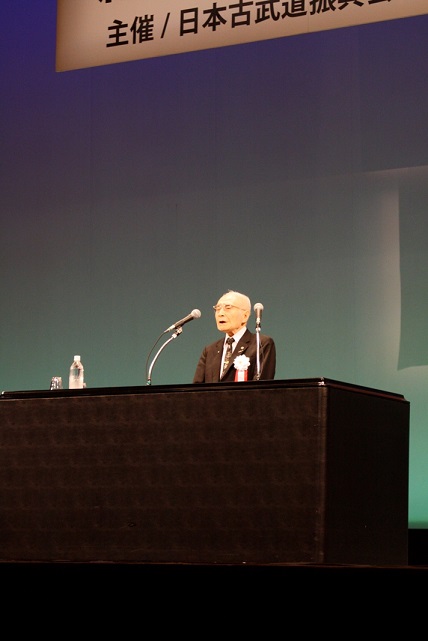 The opening address by the Chairman of the Nihon Kobudo Shinkokai, Mr. Saito
The opening address by the Chairman of the Nihon Kobudo Shinkokai, Mr. Saito
Question: How long is your term in office?
Sensei: The term of office is three years. The rules do allow for reappointment.
Question: What do you like about your job? What is enjoyable?
Sensei: What I find most enjoyable about my job is the opportunity to be able to make use of my ideas for the promotion of Japanese kobudo.
Question: Anything you dislike about your job?
Sensei: No. It is very enjoyable.
__________________________________________________________
Part Three: About the Nihon Kobudo Shinkokai
Question: What is the mandate of the Nihon Kobudo Shinkokai? Its goals and purposes?
Sensei: The aim of our association is as follows:
1) To act for the preservation and promotion of Kobudo. The various arts that comprise “kobudo” are the traditional cultural assets of our country.
2) To assume responsibility for one part of the general idea of lifetime education and wellness. In other words, one of our goals is to contribute to the maintenance and enlightenment of good morals and manners in our country.
3) To contribute to the cultivation of our human character and human nature. We aim to contribute to the raising of our youth soundly and increasing the physical strength of our young people.
Question: Can you tell us about the history of the association? How and why was it created?
Sensei: The association was created on February 3, 1935. On April 4, 1940, we, the association, got permission for the foundation of our association. And from that time onwards, we have continued to act for the preservation and promotion of Kobudo in general and all the arts which comprise it, which are Japanese traditional cultural assets.
However, with the end of World War II, the GHQ*, the General Headquarters, prohibited the practice of martial arts and went about to dissolve the martial arts groups in Japan. Furthermore, the GHQ ordered the purging of the officers of such groups. So, many groups were broken up by nomination and in sequence. Our association sensed quickly the developing situation and dissolved voluntarily and became an arbitrary group on January 1, 1946.
In spite of the intense change of social conditions, we survived. We then continued to pile up many results year after year due to the efforts of the many concerned people who thought it important to preserve this part of our cultural heritage. And I am happy to say that, due to these selfless individuals, today we have been able to reach this our 75th anniversary.
Question: What is the relationship of this association with other similar organizations? Are there other similar associations?
Sensei: Yes. There is the Nihon Kobudo Kyokai (Japanese Classical Martial Arts Association).
Question: Many Ryuha are members of your association. There must be many other Ryuha who want to be a member but are not given membership. Is there criteria for inclusion (e.g., membership requirements)? For example, what criteria do you use to accept or reject a Ryuha when it applies for membership in your association? For example, does the Ryuha have to be an old style? Does it have to be a famous style? etc…
Sensei: We examine and judge each case by itself. In other words, case by case. The applicant presents the required documents, which explain all about his Ryuha, with the evidence to us. We examine it based on the opinions of our experts (professors, etc…) about the personality, the skill, career, and tradition (the rightness of the lineage, the founder, the foundation year, etc…) of the representative of the Ryuha. And then, we judge whether or not to award membership.
__________________________________________________________
Part Four: About Associations in General (in Theory)
Question: In your opinion, what is the purpose of (budo) associations?
Sensei: Yes, that’s an interesting question. I cannot speak for all associations in general but as regards our kobudo association, I believe we have an important purpose. Kobudo is not purely about fighting and combat only. Yes, the arts that our members practice are combat arts and so naturally there is a focus on combat, on fighting. But Kobudo also includes the wisdom of how to live; how to live as a person, as a human being. If we think in terms of a single style, this is ultimately what the founder of that specific style learned under the risk of his life on a battlefield. Therefore I think that Kobudo is a precious property of not only Japan but also of all human beings, no matter what nationality they are.
I think that this is one of the missions of our Association: to have the people of the world know about it. At the same time, we want to have many Japanese people know about these Kobudo too. I think generally speaking, that this is the purpose of any association in general; namely, to have people know and understand about their particular interest.
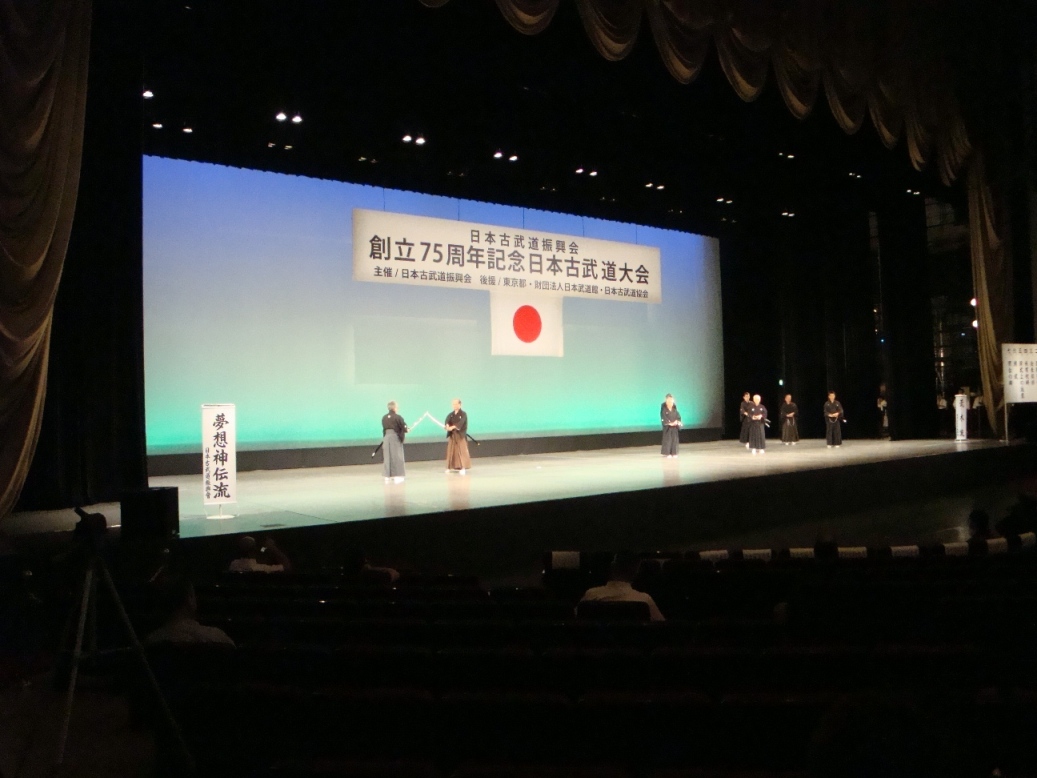
Question: What do you think are the benefits of association? (e.g., pooling resources)
Sensei: We, as in the Association, can offer a place where each ryuha can exchange skills, opinions, and so on with each other. In addition, we can become united in our efforts and can present one common interest to appeal to the world. I think that it is one of the benefits of association.
Question: What do you see as the dangers (or pitfalls) of associations? (e.g., divisive politics, cliques)
Sensei: There is a possibility that some politicians use an association for other purposes. There is a possibility that one person with a specific thought* could rule over an association. In such a case, the association’s activities would be guided by the political agenda of that leader.
(* a person with an agenda)
Question: How do you think associations fall apart or disintegrate? What do you think are some common causes?
Sensei: In the case of kobudo, each ryuha has been protecting its own unique tradition and interests for several hundred years. Therefore, it is not unreasonable that they are very self-respecting. In other words, they are proud of what they do and who they are. It is natural to feel this way. However, the danger is that it is easy to become exclusive. By this, I mean that there is the possibility that they do not recognize other ryuha.* There is also the danger that they will slander each other. If this happens, the association will not be unified. Of course, this would be the worst case scenario.
(* There is the possibility that schools become so insular, paying attention only to what they do, that they become overly proud of themselves and recognize no one else. And as a consequence, they will eventually come to slander other groups.)
Question: What do you think is necessary for an association to succeed and to grow?
Sensei: First of all, it is important to deepen the exchange between schools. Each ryuha is founded under the influence of other ryuha. What I mean is that each ryuha does not come into being in a vacuum. They are influenced by, and also in their turn influence other ryuha. They are all inter-connected with each other in many ways. You can understand your ryuha in a deep way by studying not only your own ryuha, but also other ryuha as well. But this is only possible through the interchange and exchange between the various ryuha.
In addition, through the interchange between the ryuha, I hope that all kobudo practitioners will come to see that all martial arts have a common root and in the end, they all have the same purpose. If we can achieve this kind of understanding, we can become more united and ultimately, we will be able to achieve greater things. This is what I think.
Question: As Secretary General, what do you want to achieve in your term in office?
Sensei: The activity of the Association is mainly to hold enbukai now. In our current situation, we don’t have the means to appeal to a wider audience besides our enbukai. So, first, I would like to establish the means for doing so. By this, I mean that we need to keep current with what is happening in the world. Since a lot of information is now exchanged electronically, we need to create a website for our association so that we can provide information about ourselves to the world.
Question: Thank you Sensei for this interview. It truly was a great honour for us to talk with you about your Association.
Sensei: You are very welcome.
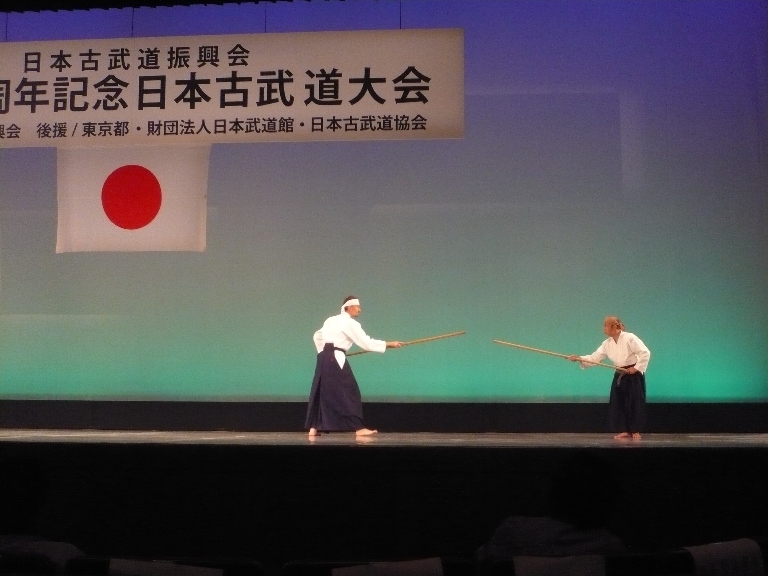 Mr. David Kawazu-Barber and Kajitsuka Sensei demonstrating Yagyu Shingan Ryu
Mr. David Kawazu-Barber and Kajitsuka Sensei demonstrating Yagyu Shingan Ryu
__________________________________________________________
Author’s post-script:
There are two major organizations in Japan which oversee kobudo (the old martial arts), the Nihon Kobudo Shinkokai (NKS) and the Nihon Kobudo Kyokai (NKK). The NKS is the older of the two organizations. The purpose of these two organizations is, more or less, the same: to recognize and preserve Japanese traditional martial arts. Many of the member schools of these organizations have been awarded the distinction of being “National Cultural Treasures” by the Japanese government. It is considered a great honour in Japan to be recognized by these organizations.
Here are some useful links for more information on these two organizations:
Website of the Nihon Kobudo Kyokai: Nihon Kobudo Kyokai
An article on the 30th Anniversary of the Nihon Kobudo Kyokai: 30th Anniversary of the Nihon Kobudo Kyokai
Discussions on budo forums about the membership of the NKS and NKK:Members of the NKK & NKS
For more information on the GHQ, see: Supreme Commander of the Allied Powers (SCAP) or GHQ
For more information on the Occupation of Japan, see: Occupation of Japan
__________________________________________________________
Douglas Tong began his studies of Yagyu Shinkage Ryu with the late Mutoh Sensei (Kajitsuka Sensei’s teacher) in Zushi-shi in 1992.
